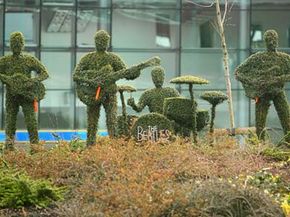Types of Topiary
Today, there are three main types of topiary -- traditional, sphagnum and trained ivy. Traditional topiary is the ornamental shaping of freestanding trees and shrubs. These plants can be large, permanent structures in expansive spaces or can lend formal elegance to even small, urban gardens. While traditional topiary can stand on its own as the main focus of your garden, you can also use it to highlight other features, like fountains, stonework or other plants.
Those with patience and a green thumb can create traditional topiary in a number of ways. While some gardeners opt for freehand clipping, using only their eye as a guide, others use frames to determine the shapes of their plants. Traditional topiarists sometimes shape stems in addition to leaves and branches by wrapping young tree stems around supportive staffs and training them into shapes like coils. And while some topiarists train young, growing plants into desired shapes over many years, others save time by purchasing mature plants and pruning them into the shape they want.
Advertisement
Sphagnum topiary, in which topiarists prune plants growing out of sphagnum moss-filled frames into desired shapes, is another way of sculpting plants. Using creeping plants, a gardener can complete a sphagnum topiary project in just a few months. Topiarists adapt this method for use outdoors -- as large freestanding structures -- and indoors -- as small tabletop decorations.
People with space and time limitations may find trained ivy topiary the most accessible. Topiarists using this method train trailing plants like ivy to grow around two- and three-dimensional wire frames to bring life to very small spaces like desktops. Hobbyists can create many shapes, from geometric forms to animal figures and even corporate logos, with this form of topiary.
On the next few pages, we'll look at how to make each of these topiary types, starting with traditional topiary.
